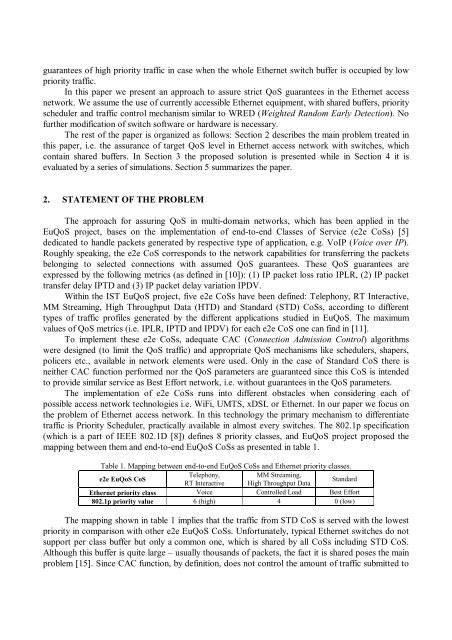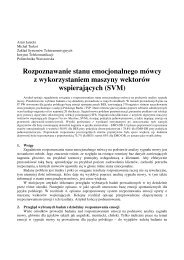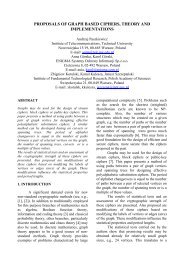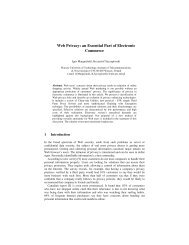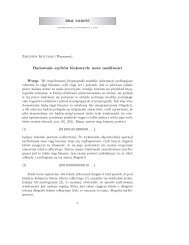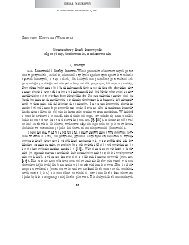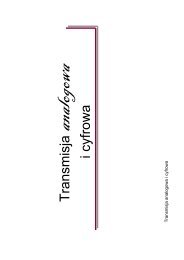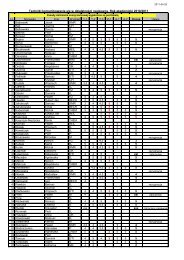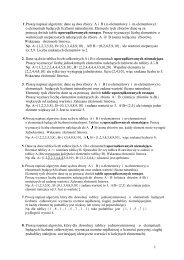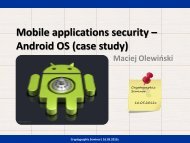supporting different classes of service in ethernet switches with ...
supporting different classes of service in ethernet switches with ...
supporting different classes of service in ethernet switches with ...
Create successful ePaper yourself
Turn your PDF publications into a flip-book with our unique Google optimized e-Paper software.
guarantees <strong>of</strong> high priority traffic <strong>in</strong> case when the whole Ethernet switch buffer is occupied by low<br />
priority traffic.<br />
In this paper we present an approach to assure strict QoS guarantees <strong>in</strong> the Ethernet access<br />
network. We assume the use <strong>of</strong> currently accessible Ethernet equipment, <strong>with</strong> shared buffers, priority<br />
scheduler and traffic control mechanism similar to WRED (Weighted Random Early Detection). No<br />
further modification <strong>of</strong> switch s<strong>of</strong>tware or hardware is necessary.<br />
The rest <strong>of</strong> the paper is organized as follows: Section 2 describes the ma<strong>in</strong> problem treated <strong>in</strong><br />
this paper, i.e. the assurance <strong>of</strong> target QoS level <strong>in</strong> Ethernet access network <strong>with</strong> <strong>switches</strong>, which<br />
conta<strong>in</strong> shared buffers. In Section 3 the proposed solution is presented while <strong>in</strong> Section 4 it is<br />
evaluated by a series <strong>of</strong> simulations. Section 5 summarizes the paper.<br />
2. STATEMENT OF THE PROBLEM<br />
The approach for assur<strong>in</strong>g QoS <strong>in</strong> multi-doma<strong>in</strong> networks, which has been applied <strong>in</strong> the<br />
EuQoS project, bases on the implementation <strong>of</strong> end-to-end Classes <strong>of</strong> Service (e2e CoSs) [5]<br />
dedicated to handle packets generated by respective type <strong>of</strong> application, e.g. VoIP (Voice over IP).<br />
Roughly speak<strong>in</strong>g, the e2e CoS corresponds to the network capabilities for transferr<strong>in</strong>g the packets<br />
belong<strong>in</strong>g to selected connections <strong>with</strong> assumed QoS guarantees. These QoS guarantees are<br />
expressed by the follow<strong>in</strong>g metrics (as def<strong>in</strong>ed <strong>in</strong> [10]): (1) IP packet loss ratio IPLR, (2) IP packet<br />
transfer delay IPTD and (3) IP packet delay variation IPDV.<br />
With<strong>in</strong> the IST EuQoS project, five e2e CoSs have been def<strong>in</strong>ed: Telephony, RT Interactive,<br />
MM Stream<strong>in</strong>g, High Throughput Data (HTD) and Standard (STD) CoSs, accord<strong>in</strong>g to <strong>different</strong><br />
types <strong>of</strong> traffic pr<strong>of</strong>iles generated by the <strong>different</strong> applications studied <strong>in</strong> EuQoS. The maximum<br />
values <strong>of</strong> QoS metrics (i.e. IPLR, IPTD and IPDV) for each e2e CoS one can f<strong>in</strong>d <strong>in</strong> [11].<br />
To implement these e2e CoSs, adequate CAC (Connection Admission Control) algorithms<br />
were designed (to limit the QoS traffic) and appropriate QoS mechanisms like schedulers, shapers,<br />
policers etc., available <strong>in</strong> network elements were used. Only <strong>in</strong> the case <strong>of</strong> Standard CoS there is<br />
neither CAC function performed nor the QoS parameters are guaranteed s<strong>in</strong>ce this CoS is <strong>in</strong>tended<br />
to provide similar <strong>service</strong> as Best Effort network, i.e. <strong>with</strong>out guarantees <strong>in</strong> the QoS parameters.<br />
The implementation <strong>of</strong> e2e CoSs runs <strong>in</strong>to <strong>different</strong> obstacles when consider<strong>in</strong>g each <strong>of</strong><br />
possible access network technologies i.e. WiFi, UMTS, xDSL or Ethernet. In our paper we focus on<br />
the problem <strong>of</strong> Ethernet access network. In this technology the primary mechanism to <strong>different</strong>iate<br />
traffic is Priority Scheduler, practically available <strong>in</strong> almost every <strong>switches</strong>. The 802.1p specification<br />
(which is a part <strong>of</strong> IEEE 802.1D [8]) def<strong>in</strong>es 8 priority <strong>classes</strong>, and EuQoS project proposed the<br />
mapp<strong>in</strong>g between them and end-to-end EuQoS CoSs as presented <strong>in</strong> table 1.<br />
Table 1. Mapp<strong>in</strong>g between end-to-end EuQoS CoSs and Ethernet priority <strong>classes</strong>.<br />
e2e EuQoS CoS<br />
Telephony,<br />
MM Stream<strong>in</strong>g,<br />
RT Interactive High Throughput Data<br />
Standard<br />
Ethernet priority class Voice Controlled Load Best Effort<br />
802.1p priority value 6 (high) 4 0 (low)<br />
The mapp<strong>in</strong>g shown <strong>in</strong> table 1 implies that the traffic from STD CoS is served <strong>with</strong> the lowest<br />
priority <strong>in</strong> comparison <strong>with</strong> other e2e EuQoS CoSs. Unfortunately, typical Ethernet <strong>switches</strong> do not<br />
support per class buffer but only a common one, which is shared by all CoSs <strong>in</strong>clud<strong>in</strong>g STD CoS.<br />
Although this buffer is quite large – usually thousands <strong>of</strong> packets, the fact it is shared poses the ma<strong>in</strong><br />
problem [15]. S<strong>in</strong>ce CAC function, by def<strong>in</strong>ition, does not control the amount <strong>of</strong> traffic submitted to


